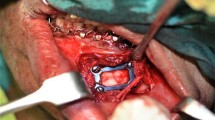Abstract
Background and Objectives
To compare the efficacy of three-dimensional (3D) miniplates with standard miniplates in the osteosynthesis of anterior mandibular fractures on the basis of bite force recordings and other clinical parameters.
Methods
A prospective randomized double-blinded clinical trial was carried out for the treatment of anterior mandibular fractures. In total, 20 patients were randomly divided into two groups of 2-mm 3D and standard titanium miniplates. The assessment of patients was done at weekly intervals for 6 weeks using bite force recordings and other clinical parameters.
Results
A statistically significant difference was found in the duration of surgery which was less in group A as compared to group B (p = 0.03). No significant difference was found in other clinical parameters.
Interpretation and Conclusion
The clinical outcome of both the 3D and standard miniplate systems in the present study was similar; however, the following advantages with the use of 3D miniplates can be highlighted:
-
Relatively lesser operating time.
-
Three-dimensional stability of the fracture site and simultaneous stabilization at superior and inferior borders in the fixation of mandibular fractures.






Similar content being viewed by others
References
Mukerji R, McGurk M (2006) Mandibular fractures: historical perspective. Br J Oral Maxillofac Surg 44:222–228
Fonseca RJ (2005) Oral and maxillofacial trauma, vol 1, 3rd edn. W B Saunders Company, Philadelphia, pp 291–293
Zix J, Lieger O, Iizuka T (2007) Use of straight and curved 3-dimensional titanium miniplates for fracture fixation at the mandibular angle. J Oral Maxillofac Surg 65:1758–1763
Alkan A, Celebi N, Ozden B, Bas B, Inal S (2007) Biomechanical comparison of different plating techniques in repair of mandibular angle fractures. Oral Surg Oral Med Oral Path Oral Radiol Endod 104:752–756
Bui P, Demian N, Beetar P (2009) Infection rate in mandibular angle fractures treated with a 2.0-mm 8-hole curved strut plate. J Oral Maxillofac Surg 67:804–808
Gassner R, Tuli T, Hachl O, Rudisch A, Ulmer H (2003) Craniomaxillofacial trauma a 10 year review of 9543 cases with 21067 injuries. J Craniomaxillofac Surg 31:51–61
Brasileiro BF, Passeri LA (2006) Epidemiological analysis of maxillofacial fractures in Brazil: a 5-year prospective study. Oral Surg Oral Med Oral Pathol Oral Radiol Endod 102:28–34
Tams J, Loon JP, Otten E, Rozema FR, Bos RRM (1997) A three-dimensional study of bending and torsion moments for different fracture sites in the mandible: an in vitro study. Int J Oral Maxillofac Surg 26:383–388
Guimond C, Johnson JV, Marchena JM (2005) Fixation of mandibular angle fractures with a 2.0 mm 3-dimensional curved angle strut plate. J Oral Maxillofac Surg 63:209–214
Farmand M (1993) The 3D plating system in maxillofacial surgery. J Oral Maxillofac Surg 51(3):166–167
Wittenberg JM, Mukherjee DP, Smith BR, Kruse RN (1997) Biomechanical evaluation of new fixation devices for mandibular angle fractures. Int J Oral Maxillofac Surg 26:68–73
Fridrich KL, Pena-Velasco G, Olson RAJ (1992) Changing trends with mandibular fractures. J Oral Maxillofac Surg 50:586–589
Khalifa ME, El-Hawary HE, Hussein MM (2012) Titanium three dimensional miniplate versus conventional titanium miniplate in fixation of anterior mandibular fractures. Life Sci J 9(2):1006
Centres for Disease Control and Prevention (CDC). Definition for surgical site infection, Atlanta, GA (2002)
Jimson S, Sankar A, Prasad R (2009) Comparative study of stainless steel miniplates, three dimensional plate and titanium three dimensional plate for fixation of mandibular fractures. Int J Maxillofac Surg 03:380
Vijay E, Balakrishnan R (2011) Three dimensional miniplate fixation in mandibular fractures. Indian J Multidiscip Dent 1(2):1
Gear JLA, Apasova E, Schmitz JP, Schubert W (2005) Treatment modalities for mandibular angle fractures. J Oral Maxillofac Surg 63:655–663
Tate GS, Ellis E III, Thockmorton GS (1994) Bite force in patients treated for mandible angle fractures: implications for rigid fixation. J Oral Maxillofac Surg 52:734–736
Agarwal M, Mohammad S, Singh RK, Singh V (2011) Prospective randomized clinical trial comparing bite force in 2-mm locking plates versus 2-mm standard plates in treatment of mandibular fractures. J Oral Maxillofac Surg 69:1995–2000
Gerlach KL, Schwarz A (2002) Bite forces in patients after treatment of mandibular angle fractures with miniplate osteosynthesis according to champy. Int J Oral Maxillofac Surg 31:345–348
Jain MK, Sankar K, Ramesh C, Bhatta R (2012) Management of mandibular interforaminal fractures using 3 dimensional locking and standard titanium miniplates—a comparative preliminary report of 10 cases. J Craniomaxillofac Surg 40(8):e475–e478
Goyal M, Marya K, Chawla S, Pandey R (2011) Mandibular osteosynthesis: a comparative evaluation of two different fixation using 2.0 mm titanium miniplates and 3-D locking plates. J Maxillofac Oral Surg 10(1):32–37
Jain MK, Manjunath KS, Bhagwan BK, Shah DK (2010) Comparison of 3-dimensional and standard miniplate fixation in the management of mandibular fractures. J. Oral Maxillofacial Surg 68:1568–1572
Renton TF, Wiesenfeld D (1996) Mandibular fracture osteosynthesis: a comparison of three techniques. Br J Oral Maxillofac Surg 34:166–173
Author information
Authors and Affiliations
Corresponding author
Ethics declarations
Conflict of interest
The authors declare that they have no conflict of interest.
Rights and permissions
About this article
Cite this article
Jain, M.K., Kerur, P. Bite Force as a Parameter for Comparison Between Three-Dimensional and Standard Titanium Miniplates for the Management of Anterior Mandibular Fractures: A Prospective Randomized Double-Blinded Clinical Trial. J. Maxillofac. Oral Surg. 18, 249–255 (2019). https://doi.org/10.1007/s12663-018-1091-6
Received:
Accepted:
Published:
Issue Date:
DOI: https://doi.org/10.1007/s12663-018-1091-6




